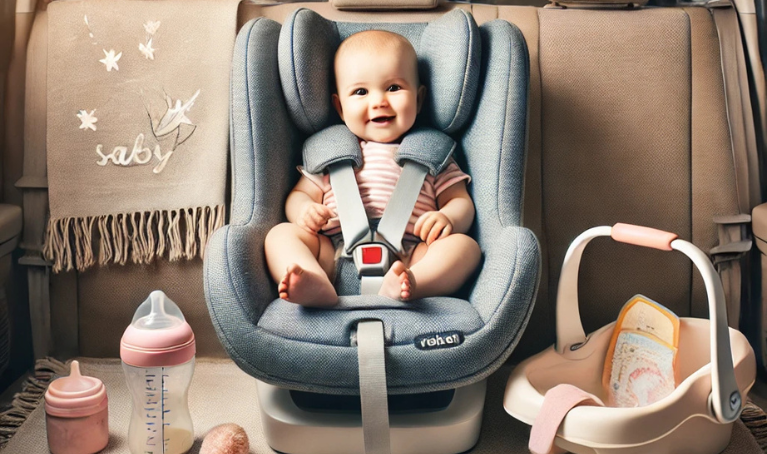Traveling with a baby can be challenging, especially when they need feeding on the go. Many parents ask, “Can you feed a baby in a car seat?” To answer this question properly, we need to consider the safety risks, possible hazards, and practicalities of feeding in a moving vehicle. This guide explores everything you need to know about feeding a baby in a car seat, from practical tips to understanding the potential dangers and precautions needed. Follow along to ensure that your baby stays safe, comfortable, and happy during your car journeys.
Table of Contents
Can You Feed a Baby in a Car Seat?
Feeding a baby in a car seat is generally not recommended unless absolutely necessary. The safest way to feed your baby is while the vehicle is stationary, as this eliminates potential risks associated with feeding in a moving car. Whether using a bottle, sippy cup, or snacks, babies can experience risks when eating in a car seat while the car is moving. However, if circumstances require feeding during a trip, it’s important to follow certain safety tips to make the experience as safe as possible. Let’s explore some best practices to keep in mind when feeding a baby in a car seat.
Tips for Feeding a Baby in a Car Seat
1. Stop the Car First, If Possible
Whenever possible, pull over in a safe location to feed your baby. Stopping eliminates the potential for movement-related risks and allows you to give full attention to feeding without distractions. It also lets you maintain the baby’s position comfortably for feeding.
2. Use Small, Soft Snacks for Older Babies
If your baby is old enough for snacks, make sure to use bite-sized, soft foods that reduce choking risks. Avoid hard, crunchy, or sticky foods, which can be difficult for babies to handle safely, especially in a moving car.
3. Consider Non-Spillable Containers
For babies on liquids, use a non-spillable sippy cup or a bottle with a slow-flow nipple. These reduce the chance of spills and keep the baby from swallowing too fast, which can happen if a standard bottle or open container is used while the car is in motion.
4. Keep a Close Eye on Your Baby
Position yourself or a responsible adult where they can easily monitor your baby. A backseat mirror may help you check on them without needing to turn around, which is essential for drivers who may get distracted by looking back too frequently.
5. Use Safety Straps Correctly
Always make sure your baby is securely strapped in the car seat when feeding, as loosening or removing the straps can increase risk during sudden stops or accidents. This way, you ensure they are both safely restrained and comfortable.
6. Be Mindful of Choking Hazards
Any food or drink given in a moving car can increase choking risks. Be extra cautious, especially with babies new to solids, and select safe foods and feeding options that won’t cause sudden choking hazards in transit.
7. Avoid Multitasking While Driving
If you’re the driver, never attempt to feed the baby yourself while driving. Only feed them when another adult can help, or, if traveling alone, pull over to do so safely. Multitasking can be dangerous and lead to avoidable accidents.
8. Pack Safe, Nutritious Snacks
For long trips, pack snacks that your baby can handle without difficulty. Choose foods that dissolve easily, aren’t likely to cause choking, and are gentle on a baby’s digestive system, reducing the chances of discomfort.
9. Schedule Feeding Breaks
Plan your trip with regular stops for feeding breaks. Not only does this make feeding safer and easier, but it also gives the baby time to stretch, relax, and avoid fussiness from being in the car seat too long.
10. Stay Prepared with Clean-Up Essentials
Feeding in a car can get messy quickly, especially with small children. Bring along wipes, a bib, and a small trash bag to keep the area clean and comfortable, preventing any lingering mess or discomfort during the trip.
Risks of Feeding Babies in Car Seats
1. Choking Hazards
One of the primary risks associated with feeding babies in car seats is choking. Babies lack control over their swallowing in a moving vehicle, making it dangerous to feed them while driving. This risk can be especially high with solid foods or if the vehicle encounters sudden movements.
2. Distraction for the Driver
Attempting to feed a baby in the car can be a distraction for the driver, especially if they’re trying to look back or manage the baby’s needs. If the driver is distracted, it puts everyone in the car at increased risk, as focus on the road is essential.
3. Aspiration Risk
If a baby swallows too fast or coughs while eating, food or drink could accidentally enter their airway, leading to aspiration. This is particularly dangerous and can happen more easily in a car due to bumps or sudden stops, posing a serious health risk to the baby.
4. Increased Discomfort for Baby
A car seat does not provide an ideal feeding position, potentially causing discomfort or gas for the baby. Babies are usually better off fed in a more upright position, especially for bottle or breastfeeding, as it can minimize issues like colic or reflux during feeding.
5. Emergency Situations
In the event of an emergency stop or accident, a baby with food or a bottle in their mouth can be injured by the sudden impact. Food or bottles can be a hazard in such scenarios, so this risk is minimized by stopping the car to feed safely.
Dos and Don’ts While Feeding Your Baby in a Car Seat
Dos:
- Do stop the car whenever possible for feeding, ensuring a safer environment.
- Do use age-appropriate snacks and bottles suited to your baby’s ability to chew and swallow.
- Do monitor your baby closely while feeding, especially in a car seat setting.
- Do use a mirror to check on your baby if you’re driving alone to avoid unnecessary turns.
- Do plan feeding breaks into your trip schedule for smoother, safer feeding routines.
Don’ts:
- Don’t feed solid foods to babies who are too young to handle them safely.
- Don’t feed the baby while the vehicle is in motion if avoidable; stop instead.
- Don’t give foods that are hard, sticky, or difficult to swallow, as these can increase risks.
- Don’t attempt to multitask by feeding your baby while driving, as it compromises safety.
- Don’t loosen or remove car seat straps during feeding, as this compromises their security.
Conclusion
While it may be tempting to feed a baby in a car seat to keep them calm during longer trips, it is generally safer to stop the vehicle for feeding whenever possible. Prioritizing safety and planning ahead with feeding breaks can make road trips with a baby smoother and more enjoyable for everyone involved. Remember that car seats are specifically designed to protect your baby in the event of a crash, so feeding should always be done with caution. By following these tips, planning ahead, and being aware of the risks, you can make your journey safer and stress-free.
FAQs
Can I feed my infant in the car seat?
Feeding an infant in a car seat is not recommended unless absolutely necessary, and it’s safer to stop the vehicle before feeding to avoid potential hazards.
Are Car Snacks for Toddlers Safe?
Soft, age-appropriate snacks can be safe for toddlers, but hard, sticky, or large foods should be avoided to reduce choking risks, especially in a moving vehicle.
Is it safe to feed baby in moving car?
Feeding a baby in a moving car increases risks, including choking, discomfort, and potential injury in sudden stops. It’s best to feed while the car is stationary to prevent these risks.
How to feed a baby on a road trip?
Plan for regular stops to feed and hydrate your baby safely. Use spill-proof bottles and easy-to-eat snacks when necessary, and avoid feeding while the vehicle is in motion.
Can You Breastfeed or Bottle Feed a Baby in a Car Seat?
Breastfeeding in a moving car seat is not recommended, as it poses significant safety risks. Bottle feeding should also be done with caution, preferably when the car is parked, to ensure safety for both you and the baby.

